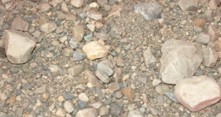The classic report, "Outline of methods for estimating ground-water supplies" (1932, USGS Water-Supply Paper 638-C), by Oscar E. Meinzer, the "father" of groundwater hydrology in the United States, emphasizes that the greatest difficulty in
applying quantitative methods to the evaluation of the hydrologic properties of an aquifer is the great variability in the texture of geologic materials.
 Texture refers to the appearance seen on a smooth surface of a homogeneous (uniform composition) rock and the size of the grains (granularity). Sands and sandstone aquifers must be interpreted with great care. Their
porosities can be computed and used in determining the safe yield of the area.
Texture refers to the appearance seen on a smooth surface of a homogeneous (uniform composition) rock and the size of the grains (granularity). Sands and sandstone aquifers must be interpreted with great care. Their
porosities can be computed and used in determining the safe yield of the area.
It is only by the carefully documented reports of water well drilling contractors that the water resources of many parts of the nation can be documented, especially in the initial or reconnaissance phase of the investigation of the groundwater, of an
area.
Because each well will pump a small part of the aquifer and add to the cumulative discharge, it is again important to keep thorough logs. Meinzer indicates that a study of the relations of the water levels to the amount of pumpage is likely
to give more reliable information as to the safe yield than can be obtained by any other method of studying an undeveloped reservoir.
For example, if the water levels in the wells remain virtually stationary during a considerable period of pumping, it can he concluded that the rate of recharge has been about equal to the rate of discharge. If, at the end of any period of pumping, the
water level does not return approximately to the position that it had at the beginning of the period, the safe yield has been exceeded and the rate of pumping is greater than the maximum pumping rate the aquifer can possibly sustain.
Reservoir capacity of fine-grained materials
The significance of storage or reservoir volume provided by fine-grained materials is commonly overlooked in developing groundwater resources. This is probably due to the fact that these beds are overshadowed by the importance attached to the search for
coarse-grained materials in which the well screen is to be placed or the borehole bottomed. Although it is advisable to place the well screen in the coarsest material available to reduce entrance losses at the face of the well, the fine-grained
material should not be overlooked.
There is an especially strong temptation to develop only the isolated lenses of coarse material, even in an aquifer made up predominantly of fine-grained material. Developing only thin lenses of gravel in this type of geologic sequence will not markedly
improve the performance of the well (compared to a well simply developed in the finer material). The withdrawal of groundwater for any prolonged period is possible only to the extent of the regional or overall capacity of the water-bearing formation. This is little influenced by isolated lenses of coarse material, except as the materials represent a small fraction of the total reservoir volume. Again, the texture of the sands and finer-grained material is very important. Fine silt might not be
capable of being developed whereas fine-grained sand should be if it represents the principal texture of the water-bearing materials.
The above information is excerpted in large part from Chapter 19 of the 1999 NGWA Press publication, Ground Water Hydrology for Water Well Contractors.